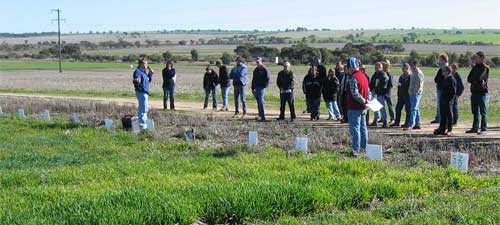South Perth, Western Australia
February 15, 2007
The Department of
Agriculture and Food, Western Australia has been conducting
research to test the competitiveness of Baudin barley with weeds
such as ryegrass.
A full review of all barley agronomy trials conducted in 2005
and 2006 will be provided at the Department’s Regional Crop
Updates in Northam on 22 February and Esperance on 8 March.
Department barley research officer Blakely Paynter said growers
often perceived Baudin to be uncompetitive because it had short
straw, allowing ryegrass heads to be visible at maturity.
|
 |
|
Barley research officer Blakely Paynter
addressing farmers at a field day in Meckering. |
He said 10 weed competition
trials were conducted in 2005, five looking at the interaction
between variety, row spacing and ryegrass and five looking at
the interaction between variety, time of sowing, seeding rate
and ryegrass.
“The competitiveness was measured in terms of the difference in
yield when grown with and without ryegrass,” he said.
“At plant densities suggested for growing barley in Western
Australia, 120 to 150 plants per square metre, no evidence was
found to support the view that Baudin was less competitive
against ryegrass than other varieties.
“In fact, what was observed was that Baudin may be slightly more
competitive against ryegrass than two other malting barley
varieties of a similar maturity, Gairdner and Vlamingh.”
Mr Paynter said that the number of ryegrass tillers measured at
the end of the season was also slightly lower under Baudin than
for Gairdner and Vlamingh, suggesting that Baudin may be able to
reduce the number of ryegrass seeds returning to the seed bank.
“This doesn’t mean that Baudin should be sown into weedy
paddocks. Baudin is an excellent malting variety and should be
given every opportunity to return high grain yields and produce
grain which meets receival specifications,” he said.
“Sowing it into weedy paddocks lowers the yield potential and
may cause it to be received into a feed segregation due to high
screenings.
“The research does however show, that the plant type exhibited
by Baudin is competitive against ryegrass, and the development
of future barley varieties with a similar plant type, is not
likely to be detrimental to the role of barley in the farming
system.”
Mr Paynter said the trial results also showed that yield loss
from the early spring malting barley variety Hamelin, was less
than the yield loss from the three medium spring varieties
Baudin, Gairdner and Vlamingh.
“Despite losing the least amount of yield when grown with
ryegrass it was not the highest yielding overall. In the 2005
season, Baudin out yielded Hamelin in the presence of ryegrass
at Beverley, Calingiri, Katanning and Mt Madden and was similar
yielding at Gibson,” he said.
“At low barley plant densities (60 to 80 plants per square
metre) there were no differences between the four varieties,
Baudin, Gairdner, Vlamingh, and Hamelin, in their relative
competitiveness against ryegrass.
“Delayed sowing did not alter the relative competitiveness of
varieties against ryegrass, nor was there any interaction with
row spacing.”
Regional Crop Updates are supported by the
Grains Research and Development
Corporation.
|
|